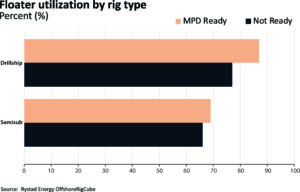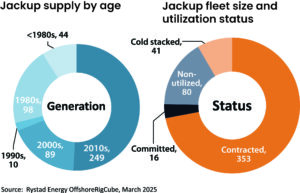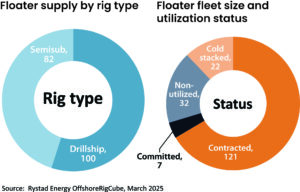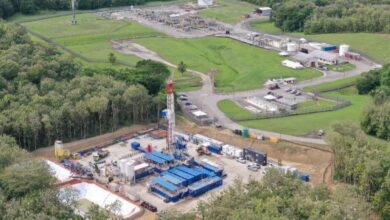Strategic upgrades likely to sustain offshore rig fleet in foreseeable future
Growth potential to remain centered around reactivations and investing in advanced equipment, although cost tensions remain

By Stephen Whitfield, Senior Editor
The combination of strong oil demand and high oil prices during the offshore drilling upcycle in the early 2010s spurred a wave of orders for newbuild rigs, particularly for high-spec jackups and deepwater and ultra-deepwater floaters. Then, when oil prices collapsed following the 2014 downturn, the market became oversaturated. Many drilling contractors decided to delay or cancel deliveries, while some newbuilds that were delivered ended up being immediately cold- or warm-stacked. Additionally, many existing rigs were retired.
Heading into this year, there was optimism that the offshore drilling market was moving into an extended upcycle. According to Esgian, leading-edge dayrates for seventh-generation drillships exceeded $500,000 in 2024, in some instances surpassing $600,000 for the highest-spec unit with a 20,000-psi BOP. Dayrates for harsh-environment semisubmersibles exceeded $500,000 last year, as well.
However, the short-term outlook for offshore is less optimistic as 2025 approaches its midpoint. Matthew Donovan, Head of Rig Research at Esgian, said there will be “a lot of white space” in the offshore market as rigs come off contract with no future work scheduled. Moreover, there’s uncertainty around where the market will fall in 2026.
Even if that uncertainty settles and the market does move upwards, he said, drilling contractors will remain far more disciplined and cautious than they had been during previous upcycles.
Money is a primary factor behind the continuing lack of interest in more newbuilds. Companies that survived the oil price downturns have less access to capital in the current market environment and, combined with the excess rig supply that still plagues the market today, there is little to no appetite for adding even more rigs.
“When you look at newbuilds, it’s much, much cheaper to reactivate a rig than it is to build a new rig. If you need additional capacity and you have a rig that’s stacked, you’re much better off bringing that rig back online,” Mr Donovan said. “There’s been a lot of refreshment in the fleet over the past decade. We had that pre-2014 building boom, and we have newbuilds that haven’t even been delivered yet.”
On top of that, newbuild construction costs have risen significantly since the last round. Mr Donovan estimated that it could cost as much as $300 million to order a jackup, and potentially $1 billion to order a new floater. By comparison, seventh-generation newbuild floaters were being ordered for between $500 million and $700 million in the early 2010s. With such inflated prices, operators would need to underwrite any order with extremely high dayrates and long contract terms to the drilling contractors.
The economics of newbuilds have led both operators and drillers to focus primarily on prolonging the useful life of existing rigs as much as possible. That means, instead of a newbuild cycle, the offshore market could see an upgrade cycle.
“I think what we have right now is a lot of interest in whether you can upgrade and work with what you have,” Mr Donovan said. “In the grand scheme of things, a lot of these companies have very good, fairly new rigs. When the time comes, they’re going to look at how do they keep those rigs working for an extended period of time, rather than trying to find new ones.”
Analysts describe an upgrade cycle as a lateral solution – meeting the potential for increased demand in the future while keeping rig numbers stagnant. If the upgrades are made strategically, this could be a win-win situation. However, this depends on whether the contractors are compensated for the upgrades and if operators can find a way to claw back their initial investment with lower project costs.
“The real tension we’re seeing right now is in bringing rigs that are on the sideline back into service, and who’s going to pay for that?” said Matt Hale, Senior VP of Drilling & Wells Research at Rystad Energy. “That’s a much bigger question than asking which system to install. Operators want to avoid that cost as much as possible, and I think they will until they absolutely can’t. The contractors are the same – they need the right commitment to do that, either with the cost upfront or with the term. It’s a balance.”

Upgrades and the newbuild cycle
When asked whether there were equipment needs that operators are asking for but that the current fleet is unable to meet, Mr Hale was quick to say “yes.” However, he qualified the answer by dividing “equipment needs” into three categories. First are the upgrades that do not require changes to the rig’s physical layout, like software installations. The second category involves upgrades like managed pressure drilling (MPD) systems, which typically require some kind of retrofit but not a complete overhaul. The third category consists of extreme overhauls, like a 20K BOP.
The first and third categories are not particularly noteworthy, Mr Hale said. Software upgrades are relatively cheap, and 20K BOPs are so costly that only two rigs are even using them (Transocean’s Deepwater Titan and Deepwater Atlas drillships, both of which are working in the US Gulf of Mexico). A third (the Stena Evolution drillship from Stena Drilling) is set to receive a 20K BOP upgrade next year.
The second category of upgrades, he said, is where the industry will likely see more movement in the coming years. In particular, he pointed to MPD systems as the big differentiator in the offshore market. According to Rystad, MPD-ready floating rigs have shown higher utilization rates globally in 2025 (87% for drillships and 69% for semis) than rigs that are not MPD-ready (77% for drillships and 66% for semis). Rystad defines “MPD ready” as rigs that have the piping and other modifications necessary to deploy an MPD system.
“Before the last two or three years, the companies that were pushing MPD were the ones with wells that had these very narrow pressure gradients. They were looking at things that they could do to make what may be technically impossible wells drillable,” Mr Hale said. “But now the operators have seen much more of the performance benefits in terms of drilling faster and not having to slow down for certain pressure zones. I think that’s where the shift is. There’s been a recognition among operators that you can drill faster with these MPD systems across almost any well. In that sense, the operator thinking has shifted, and they’re willing to spec this in their tenders.”
That shift in operator thinking will likely further the disparity in utilization between floaters that are MPD-ready and those that are not, both in the near- and long-term future. To that end, Mr Hale noted that more drillers are starting to invest in MPD system upgrades in advance of bidding on contracts.
“I think we’ve reached a tipping point where drilling contractors are willing to make the investment ahead of the operators’ tendering requirement,” he noted. “In the past, they would say, yes, we can do this upgrade – but only if you pay us first for the project. That’s shifted a bit over the past two or three years where it’s becoming much more of a norm. The drilling contractors realize that, for your rig to be competitive, you need this.”

This shift in attitude toward MPD systems highlights the nature of the discussion around rig equipment in the industry, Mr Hale continued. If there are equipment needs down the road that drilling contractors cannot match with their fleet, they will want fair compensation for the retrofit. But, ultimately, drilling contractors are responding to operator demands, and if operators put upgrades into their tenders, the onus is on the drilling contractor to either bid or not bid.
However, Mr Hale added the caveat that market forces could also affect the balance of discussion on who pays for upgrades. He noted that Rystad is “very bullish” on global deepwater markets over the long term – Rystad projects deepwater to see a compound annual growth rate of 8% from 2025 to 2028, with deepwater E&P becoming the single largest growth segment in the oil and gas industry over that time period.
“The operators care very much about the economics on these projects. There’s a lot of good resources with low breakevens, low emissions, and a lot of good deepwater projects to develop. At the same time, some of the costs have risen to a point where they’re going to say, this isn’t what I penciled it in to be when I went out to bid, so I’m going to defer it or rebid it. They’re finding ways to take the costs out even though the overall market economics are good. And the same thing’s happening on the contractor side,” Mr Hale said.

The focus on capital discipline in the wake of the two downturns in the past decade, coupled with rising costs and long lead times, have created an environment that Mr Hale said is unlikely to spawn a newbuild cycle anytime in the foreseeable future.
One indicator behind this belief is the steady decline in rig retirements over the past few years. Floater retirements, which were routinely hitting the mid- to high 20s annually a decade ago, have now stayed in single digits each of the past four years. This year, six retirements are expected.
At the same time, floater deliveries have gone up, with 2025 projected to hit the highest delivery total since 2015. Global jackup deliveries have settled following a boon in the late 2010s, but retirements have also dropped to near zero (one retirement each in 2023 and 2024, and none projected for 2025).

Additionally, both the jackup and floater fleets have a high number of rigs that are marketed but not currently utilized (17% of floaters are not utilized as of March 2025, along with 16% of jackups). These figures, Mr Hale said, indicate a market where drillers are going to prioritize doing whatever they can to keep their existing rigs active.
“I think the focus is going to be on steadily bringing back a few rigs over the coming years. We know the demand’s going to be there, so they just have to be brought back,” he commented.
The useful life of a rig
The question of the future offshore market and rig upgrades may seem separate from the question of a rig’s useful life, and to some extent they are. Mr Donovan said that determining the useful life of a rig depends on the rig itself. While offshore rigs generally have a lifespan of 25-30 years, that time frame could be affected significantly by a rig’s capabilities or the overall condition of its equipment.
Still, Mr Donovan acknowledged that new rig construction will become necessary at some point, and drillers will have to replace aging units that might not be cost-effective to upgrade anymore, or that will not meet technological, technical or environmental requirements. “There’s going to be continued demand for offshore drilling, especially in the deepwater and challenging environments, and that will require new building,” he said.
But “we’re going to be quite a long way off in terms of actual orders,” he added, and while there’s no crystal ball indicating exactly how long the current fleet will last, he expects drillers to delay a newbuild cycle for as long as they can.
“The big drilling contractors – the ones who still have rigs in cold stack – are more focused on what they can do for their active fleet. That’s always going to be your first priority. Right now, we have excess capacity in the market that has not been fully absorbed, so we have to see when we’re going to see the pickup in activity,” Mr Donovan said.
Even if the appetite for newbuilds does grow, he pointed out that the relative youth of the existing offshore fleet means most contractors won’t have to think about the useful life of a rig for a while. Esgian estimates that 66% of the global jackup fleet and 85% of the global floater fleet are 20 years old or less. Moreover, many of the rigs above that age have had extensive upgrades or rebuilds during their lifetime.
“We’ve still got jackups from the 1970s working, and these units from the 2010s that are fairly premium units have a long life ahead. It’s not like we’re coming to a near-term cliff. And with floaters, you’ve got this modern generation of floaters delivered around 2013 and 2014 – a lot of seventh-generation drillships especially – that have many productive years ahead of them. They’re well positioned to be in demand going forward.”
The floater market has seen a greater shift to deepwater and ultra-deepwater wells over the past decade, meaning that the market for midwater semisubmersibles is likely going to stay dim in the near-term future. In fact, Mr Donovan noted that most of the non-harsh environment midwater semis have already been retired. This has eliminated a lot of the older semis from the market – the older units that still remain active have generally undergone extensive rebuilds or upgrades.
The market for sixth-generation semis and drillships is also likely to stay more challenging, he continued. “They’re not at the top of the heap in terms of demand. It’s more of the seventh-generation units that are getting attention.”
Mr Donovan attributed the recent retirement of several relatively young semis and drillships by Valaris and Noble primarily to short-term market risks. He doesn’t believe they are indicative of any changes in the anticipated lifespan of an offshore rig, but rather are simply the result of company-specific decisions about balancing the cost of holding onto an idle rig, especially with a lot of rigs rolling off of contracts this year.
“With Noble, they’re making the decision that they don’t see those particular rigs coming back in the next several years. That’s a calculation each company is going to make,” he explained. “Valaris has some cold-stacked units, and even though they may not see possibilities for some of them in the short term, beyond the next couple of years they see a way for some of them to return. Regardless, it gets difficult for some companies to handle the reactivation costs and the time needed to bring them back. We’re not in a period right now where we’ll see a rash of reactivations, but in the next couple of years, there’s a possibility. It just depends on what demand materializes.” DC




